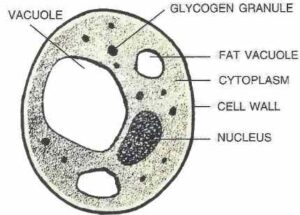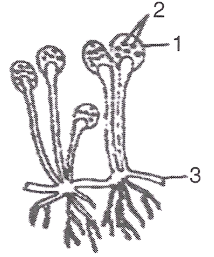Economic Importance of Fungi Structured Answer Biology Class-9 ICSE Selina Publishers Solutions Chapter-9 Part B. Step By Step ICSE Selina Concise Solutions of Chapter-9 Economic Importance of Fungi with Exercise-9B including MCQs, Very Short Answer Type, Short Answer Type, Long Answer Type and Structured/Application Questions Solved . Visit official Website CISCE for detail information about ICSE Board Class-9.
Economic Importance of Fungi Exe-9B Structured Answer Biology Class-9 ICSE Concise Selina Publishers
| Board | ICSE |
| Publications | Selina Publication |
| Subject | Biology |
| Class | 9th |
| Chapter-9 | Economic Importance of Bacteria and Fungi |
| Book Name | Concise |
| Topics | Solution of E. Structured/Application/Skill Answer Type Part B |
| Academic Session | 2023-2024 |
E. Structured/Application/Skill Answer Type
Economic Importance of Fungi Class-9 Biology Concise Solutions
Page 100
Question 1.
If you leave a piece of moist bread covered under a small bell jar at a warm place, mould grows on it in a few days. Answer the following with reference to this observation:
(a) How did the mould get inside the bell-jar?
(b) What would happen if the bread was not covered by the bell-jar?
(c) What would happen if moist bread was placed in a refrigerator?
(d) What happens first on the bread-the mycelia or the spores?
(e) How does bread mould obtain nourishment? What type of nourishment is it- epiphytic, autotrophic, parasitic symbiotic, or saprophytic?
Answer:
(a) Moulds are commonly present in air, water, etc. Hence, they were already present when moist bread was kept covered with the bell-jar.
(b) If bread was not covered with the bell-jar, moulds would have still appeared, but after some time. The warm and humid conditions inside the bell-jar promote rapid production of mould.
(c) Moulds do not grow below freezing point inside a refrigerator.
(d) Mycelia appear first on the bread.
(e) Bread mould obtains its nourishment through extracellular digestion from the substratum on which it grows. This mode of nourishment is called saprophytic nutrition.
Question 2.
Draw a neat diagram of the unicellular fungus ‘Yeast’ and label its six important parts.
Answer:
Below is the diagram of Yeast with its six important parts labelled:

Question 3.
The figure shown alongside represents an organism. Study the figure and answer the following questions.

(a) Identify the organism and write its common as well as scientific name.
(b) Label the parts shown as 1, 2 and 3.
(c) Name two suitable habitats of the organism shown.
(d) Mention its main mode of reproduction.
(e) What specific kinds of digestion occur in it ?
Answer:
(a) The organism show in figure is bread mould.
Common Name — Moulds
Scientific Name — Rhizopus
(b) The parts are:
- 1 → Sporangium
- 2 → Spores
- 3 → Hyphae
(c) They prefer warm and humid climate and organic material like fruits, bread, leather etc. to grow.
(d) It shows asexual reproduction as well as sexual reproduction. Asexually it reproduces by spore formation. A few hyphae become erect (sporangiophores) and swell at the tip to form sporangium. The sporangium containing spores burst to spread the spores. The spore germinates to form hyphae when it finds favorable conditions.
(e) Extracellular digestion.
— : End of Economic Importance of Fungi Part (B) E. Structured/Skill Answer Class-9 ICSE Biology Solutions :–
Return to Return to Concise Selina ICSE Biology Class-9
Thanks
Please share with your friends


